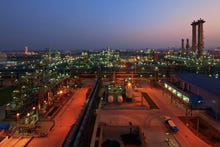Wacker Chemie AG and Dow Corning Corp. inaugurated their joint integrated silicone manufacturing site in Zhangjiagang, Jiangsu province, China, investing $1.8 billion in the 1 million m2 facility, which they call one of China's and the world's largest integrated silicone production sites. Featuring jointly owned siloxane and pyrogenic silica plants, the site also has independently owned and operated finished silicone production operations.
November 18, 2010
Wacker Chemie AG and Dow Corning Corp. inaugurated their joint integrated silicone manufacturing site in Zhangjiagang, Jiangsu province, China, investing $1.8 billion in the 1 million m2 facility, which they call one of China's and the world's largest integrated silicone production sites. Featuring jointly owned siloxane and pyrogenic silica plants, the site also has independently owned and operated finished silicone production operations.

Wacker, Dow Corning integrated silicone production site in China.
The plant's output will target China's automotive; construction; cosmetics and personal care products; electronics; power generation and distribution; solar energy; and textiles markets. Work on the project began in 2006, with the first phase of raw material production launched in 2008. The combined annual capacity for siloxane and pyrogenic silica is expected to reach approximately 210,000 tonnes.In a third-quarter earnings statement, Dow Corning's executive VP and CFO, J. Donald Sheets, called the plant opening a "major milestone," saying that Asia is currently the largest and fastest growing region for its silicone products. In its third-quarter report, Wacker said that the greater China region accounted for about 60% of the company's Asian sales.
The companies said the joint-venture approach, including operating shared facilities, provides the business economies of scale through the sharing of power, utilities, and subsequent efficiencies. By integrating production of silicone precursors, the companies say environmental and logistical efficiencies can be gained, with he closed-loop facility allowing the siloxane plant to supply chlorosilane for the production of pyrogenic silica. In turn, the pyrogenic silica plant will send back its by-product, hydrogen chloride (HCL), for the production of siloxane.
Wacker employs 15,600 people at 26 production sites in Europe, the Americas, and Asia. In addition to the new, shared site in Zhangjiagang, Wacker has a production facility in Wuxi. Dow Corning, which is itself a joint venture between Dow Chemical Co. and Corning, employs 9000, with production sites in North and South America, Europe, India, China, Korea, and Japan.
In a report released in October, Global Industry Analysts Inc. noted that Asia-Pacific is projected to be the fastest growing regional market for silicone, with an average annual growth rate of more than 3.0% through 2015. The report stated that, "Surging Chinese and other developing economies in the region represent primary growth drivers. China is a leading global producer and one of the leading exporters of silicon and ferrosilicon worldwide."
About the Author(s)
You May Also Like


